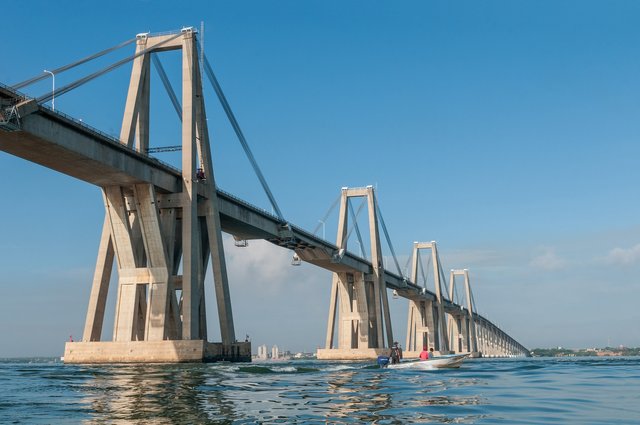Maracaibo and its history
Design: @soldiaz
I designed the poster with the Adobe Illustrator tool.
The city of Maracaibo is the place where I currently reside. I would like to compare with you a summary of its history.
In the western end of Venezuela, in the Zulia state, is Maracaibo, the second city of Venezuela and together with the Eastern Shore of the Lake, forms an important oil center. Maracaibo is located on the shores of the lake that bears his name and was discovered on August 24, 1499, by the sailor Alonso de Ojeda, colón's companion on his second trip.
The city of Maracaibo was founded on three occasions. The first time was in the year 1529, by the German Ambrosio Alfinger who gave the name of Maracaibo or Villa de Maracaibo. This had little activity and as a consequence in 1535, Nicolás Federmán ordered to evacuate and move his population to the end of the Vela in the vicinity of Coro. After a second unsuccessful attempt on the part of Captain Alonso Pacheco, it was not until 1573 that the Governor Diego de Mazariegos decided to re-establish the town by entrusting Captain Pedro Maldonado with this assignment. Thus, in 1574, the Nueva Zamora de Maracaibo was founded in honor of Governor Mazariegos, a native of the city of Zamora in Spain. From this last Maracaibo foundation, it begins to develop step by step and to grow as a city in every way.
The origin of his name is due to the brave Cacique Mara, strong man of no more than 25 years, who lived on the island of Providencia and opposed the Germans who attacked the area, perishing in the battle against the Germans. It is said that, when seeing his boss dead, the Indians shouted: "Mara-fell"! and this is how the name of the Zulia capital originated. Although other investigators affirm that, the place where the marabina city rises, it was called then in Indian language "Maara-iwo" that is translated to the Spanish like, "place where the snakes abound".
One of the things that draws Maracaibo's attention is the color of its churches and colonial houses, such as the one of the Church of Santa Bárbara. Recently, a walk that goes from this Church to the Basilica of Our Lady of the Chiquinquirá was inaugurated.
El cartel lo diseñé con la herramienta de diseño Adobe Ïllustrator.
La ciudad de Maracaibo es el lugar donde resido actualmente. Me gustaria comparartir con ustedes un resumen de su historia.
En el extremo occidental de Venezuela, en el estado Zulia, se encuentra Maracaibo, la segunda ciudad de Venezuela y junto con la Costa Oriental del Lago, forma un importante centro petrolero. Maracaibo se encuentra a orillas del lago que lleva su nombre y que fue descubierto el 24 de agosto de 1499, por el marino Alonso de Ojeda, compañero de Colón en su segundo viaje.
La ciudad de Maracaibo fue fundada en tres oportunidades. La primera vez fue en el año 1529, por el alemán Ambrosio Alfinger quien le dió el nombre de Maracaibo o Villa de Maracaibo. Esta tuvo poca actividad y como consecuencia en 1535, Nicolás Federmán ordenó evacuar y trasladar su población al cabo de la Vela en las cercanías de Coro. Después de un segundo intento fallido, por parte del capitán Alonso Pacheco, no es sino en 1573 que el Gobernador Diego de Mazariegos, decidió restablecer la población confiándole al capitán Pedro Maldonado dicha encomienda. Así para 1574 fue fundada la Nueva Zamora de Maracaibo en honor al gobernador Mazariegos, nativo de la ciudad de Zamora en España. A partir de esta última fundación Maracaibo, comienza a desarrollarse paso a paso y a crecer como ciudad en todos los sentidos.
El origen de su nombre se lo debe al aguerrido Cacique Mara, hombre fuerte de no más de 25 años, que vivía en la isla de Providencia y opuso resistencia a los alemanes que atacaban la zona, pereciendo en la batalla contra los germanos. Se dice que, al ver muerto a su jefe, los indios gritaban: ¡"Mara-cayó"! y así se originó el nombre de la capital zuliana. Aunque otros investigadores afirman que, el sitio donde se levanta la urbe marabina, se llamaba entonces en lengua india "Maara-iwo" que se traduce al español como, "lugar donde abundan las serpientes".
Una de las cosas que llama la atención de Maracaibo es el colorido de sus iglesias y casas coloniales, como por ejemplo el de la Iglesia de Santa Bárbara. Recientemente, fue inaugurado un paseo que va desde esta Iglesia hasta la Basílica de Nuestra Señora de la Chiquinquirá.
www.venezuelatuya.com

